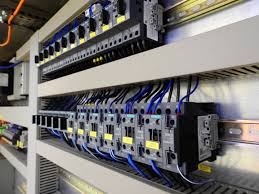Circuit Control Of Electrical Motor Start Relay
In the control circuit start relay 'S' gets energised arremains held only when the "O" contacts of all the master controllers (Hoist, LT and CT) are in closed position
ie., levers are in OFF position.
On moving the drum switch handle to position
1. on the right for hoist operation contact UF
losing of this contact energises contactor 1M
ed the up limit switch contact is closed. When
actor TM energises it starts the motor to raise
weight up at a slow speed because all the resistances are included in the rotor circuit of the electrical motor.
2. When contact 1M is energised its NC contacts 1M and 1M are open and acts as interlock for downward operation. Contact 1M closes and timer 1T is
energised.
3. After a preset time the contacts of 1T, 1T, closes. Now if the drum switch is moved to position 2. The NO, closes and 1 contactor is energised and a set of resistance is removed from rotor circuit of hoist motor and it runs at a higher speed. Contact 1R. also closes and timer 2T is energised.
4. After a preset time the contact of 2T is closed. Now if the drum switch is moved to position 3, the NO closes and 2R contactor is energised and a set of resistance is cut off from the rotor circuit and hoist and timer 3T is energised. motor runs at a still higher speed, contact 2R closes motor runs at still higher speed.
5. After the preset time, the lever is moved to position 4. Electrical Motor.
6. To prevent over hoisting an up limit switch is provided if upper limit is reached upper limit switch is activated and ULS, opens and M is de energised.
7. For downward motion the lever is put in left side to position 1 contact 1 down is actuated and energises conductor 2M' gives 2 phase supply to the motor and Electrical motor produces less torque and the brake also does not release fully due to single phasing.
8. A timer T also gets energised in after a preset time T, opens an where as contact T closes to one Energisation of contator 2M motor for lowering operation.
9. Removal of resistance is in the same the case of raising operation ELEVATOR (OR) LIFT.
ie., levers are in OFF position.
On moving the drum switch handle to position
1. on the right for hoist operation contact UF
losing of this contact energises contactor 1M
ed the up limit switch contact is closed. When
actor TM energises it starts the motor to raise
weight up at a slow speed because all the resistances are included in the rotor circuit of the electrical motor.
2. When contact 1M is energised its NC contacts 1M and 1M are open and acts as interlock for downward operation. Contact 1M closes and timer 1T is
energised.
3. After a preset time the contacts of 1T, 1T, closes. Now if the drum switch is moved to position 2. The NO, closes and 1 contactor is energised and a set of resistance is removed from rotor circuit of hoist motor and it runs at a higher speed. Contact 1R. also closes and timer 2T is energised.
4. After a preset time the contact of 2T is closed. Now if the drum switch is moved to position 3, the NO closes and 2R contactor is energised and a set of resistance is cut off from the rotor circuit and hoist and timer 3T is energised. motor runs at a still higher speed, contact 2R closes motor runs at still higher speed.
5. After the preset time, the lever is moved to position 4. Electrical Motor.
6. To prevent over hoisting an up limit switch is provided if upper limit is reached upper limit switch is activated and ULS, opens and M is de energised.
7. For downward motion the lever is put in left side to position 1 contact 1 down is actuated and energises conductor 2M' gives 2 phase supply to the motor and Electrical motor produces less torque and the brake also does not release fully due to single phasing.
8. A timer T also gets energised in after a preset time T, opens an where as contact T closes to one Energisation of contator 2M motor for lowering operation.
9. Removal of resistance is in the same the case of raising operation ELEVATOR (OR) LIFT.



Comments
Post a Comment